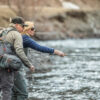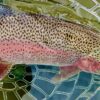
There is nothing finer than spending the days leading up to and beyond the Autumnal Equinox than fly fishing the rivers of the Sun Valley region. Add to that the opportunity to view the full line of rifles, shotguns and handguns in the Beretta Mobile Showroom at our downtown store while eating sliders and sipping complementary cold beverages, and you have a recipe to make the first official day of fall the best day of the year. While we have been enjoying some fall like conditions already with cool mornings and a few cloudy days, as we officially transition into fall we should continue to experience fantastic fishing. A few golden leaves are beginning to line the edges of our freestones and intermittent patches of brilliant yellow can be seen. The water temps are nice and cool, ranging from the high 40s to the mid 50s depending on the day and where you are on the river. These cooler water temps are triggering the bugs of fall to hatch and signaling to the fish that it is time to fatten up before the onset of winter. All true anglers know…the next several weeks are the best time to be on the water. Sliders, beers, bugs, trout and guns…what more could we ask for?
Silver Creek
If you are heading down to the Creek be prepared for a variety of situations. On the unseasonably warm days, you may still find a few Tricos mixed with some Baetis on the water by midmorning and into the middle of the day. This hatch may be strong enough to get the small fish into pods but may not get the larger fish involved on the surface. To get the bigger fish, you might try running a dry dropper rig through the runs where you can see the bigger fish holding. A hopper with a small beaded or non-beaded pheasant tail is a good option. Also Zebra midge and WD40s can be effective. On the cloudy days, expect the Baetis in size 22 and 24 to be the dominate hatch. These hatches are generally strong enough to get most all the fish involved on surface feeding. You will need a long leader down to 6x, and as always on the Creek, you should position yourself so the fish see the fly first and not the leader. Of course, the Callibaetis (size 18) are still going to be a factor latter in the day in the pond and sloughs. The Mahogany Duns (size 16) will also keep getting stronger. When I see this bug on the water, often I will switch to it as the fish may tend to prefer it over all the other options available. Still my favorite option this time of year is terrestrial fishing. On windy days, I will shorten my leader down to a stout 4x and tie on a hopper or an ant and cover the likely water: cut banks, drop offs, channels between the weeds, etc. I prefer to do this from a float tube so I can cover a ton of water. The takes can be spectacular. If you do this from a tube, be prepared for the cold water and wear an extra layer under your waders. Float tubing this time of year can be frigid. Another option on windy days is to head to one of the sloughs. These fish will often feed heavily during windy conditions and anglers can really capitalize on this.
Big Wood River
Good bugs, eager trout and few other fishermen all make September on the Wood an angler’s paradise. The fish can be found in every part of a run from the shallow riffles at the top to the shallow tailouts at the bottom. In the shallow tailouts, I like fishing small parachute patterns in size 18 and 20 like a Gulper Special or a Harrop’s Baetis. You might consider using a flying ant or a small ginger Crane fly as well. These fish are skittish so use long leaders and 6x. Approach the fish from above and employ a slack line cast and allow it to drift fly first on these selective feeders. There is no need to make repetitive blind casts on these fish, instead patiently wait for a fish to show itself and then make a cast. For the shallow riffles, a small nymph tied off a Hecuba or a hopper will do the trick. The Hecubas are coming on strong in the afternoons, especially if there is some cloud cover. And if the fish are in the shallow, fast water they are mostly picking off the Baetis nymphs and emergers, so a small beaded Baetis nymph will be best. When fishing the big bugs, like the Red Quill, a hopper, or an ant you can easily get away with using 5x, but you still need to exercise caution. Nymphing the deeper water on the Wood this time of year can also be extremely productive. A simple dry dropper rig is very effective. Simply match the length of your tippet to your dropper with the depth of the water. For nymphs try a small size 16 or 18 Zebra Midge in red or black, a bead head pheasant tail, Bishop’s Dynamite, or Rainbow Warrior. For all the above mentioned nymphs, I prefer tungsten beads to help get them down to the fish. If you go, the best fishing is from about midmorning till early afternoon.
Big Lost River below Mackay
The Kokanee are still above the reservoir and their numbers should start to decrease since they hit their peak last week. Many anglers have been taking advantage of this, and the fishing is beginning to get tough due to pressure. But the fishing below the reservoir remains very good. Last week the flows dropped to around 300 CFS and they have been holding steady; however, as the need for irrigation down stream decreases we may see they flows go down again. Check the Idaho River Flows link on our website to see current flows before you go. Otherwise things haven’t change much from last week. Look for Tricos and Baetis from late morning and through the middle of the day. When the bugs are gone, be prepared to nymph. Of late, the fish are harder to hook, which may be because of the pressure they are under from anglers. The key to success on these fish is contact with your flies. European Nymphing techniques will increase your catch rate dramatically. For bugs, be sure to have Crane Flies, Tricos ( size 22-24), Baetis (size 18-20) and an assortment of nymphs such as King Princes (size 12, 14), San Juan Worms, Flashback Pheasant Tails (size 14, 16), Bishop’s Dynamite (size 14, 16, 18), Zebra Midge (size 16,18) WD40s (size 18,20) and Rainbow Warriors (size 16,18,20).
Upper Big Lost
The reports have been mixed all summer on this fishery and the September reports have been no different. Still if you decide to go, the best action is happening on the Main Stem of the Upper Lost from the North Fork confluence and down. The river is low and the fish are spread out. You can expect there to be maybe one good fish per run with only one legitimate chance at getting a strike…so make it count. The fishing is best from the middle of the day into the late afternoon. Don’t expect to see too many bugs and be prepared to cover a lot of ground to find fish. The Whitefish are eager to eat a fly and a few quality Rainbows, Cutbows, Brook Trout, and Cutthroat can be found as well. If you are looking for huge numbers of trout, stick to the Wood, but if you want to search gorgeous water for that one fantastic trout, give this a try. And you are guaranteed solitude. Take along an assortment of your favorite attractor dry flies and nymphs as well as your standard parachute patterns: Parachute Hare’s Ear, Turk’s Tarantulas, PMX, Royal Wulffs, King Prince, Flashback PTs and Zebra Midge.
Salmon River
Despite the fire, there are fishing opportunities in this area. Most days are clear of smoke and it is worth the trip just to see the Sawtooths against the blue sky of September. Check with us about road closures if you plan on fishing beyond Stanley, but there are plenty of good access points along the river above the town of Stanley. For flies, I still like Yellow and Orange Stimulators even though the Stones are long gone and attractors such as Turk’s Tarantula as well as Hoppers work great. Nymphs, such as Tungsten PTs and Rainbow Warriors in size 16 tied of the back of these big bugs will also be good producers.
Warm Springs & Trail Creek
If you like stocking fish in shallow water, than you might give these two Big Wood tributaries a go. The water will be very low and the wild fish will be shy. During the summer Fish and Game stocks these rivers around the bridges and anywhere the rivers near the road and some of these fish will still be around. But, if you seek wild fish, just leave the beaten path and explore. Be stealthy. As long as the fish are not scared they will eat the usual attractor drys and nymphs.
South Fork of the Boise
The flows have dropped to around 500 CFS. This is the level when the wade fishermen take back the river and the armada of drift boats disappear. As always, look for Pinks and Flavs along with fall Baetis during the comfortable times of the day. Also expect to see craneflies skittering about followed by a vicious take. The caddis in the evenings have remained quite strong and it is still worth fishing right to dark during these unseasonable warm days. If you find no bugs about, you might try a hopper as well. Nymphing is also going to be productive with the usual suspects such as PTs (size 16-20), Zebra Midge (size 18,20), as well as stoneflies and caddis larva imitations. I like nymphing with either a stone or caddis larva as an anchor fly along with a smaller midge or mayfly imitation when nothing else is going on.
Area Reservoirs
It is that time of year when I begin thinking about spending some time on one of our local reservoirs again. Little Camas, Magic, Mackay, or Duck Valley are all going to be fantastic options this time of year. The fish are going to be anywhere from 2 to 4 inches bigger from this spring and just like their brethren in the river they will begin to feed voraciously to fatten up for the onset of winter. So grab some fins and a tube and hold on to your rods…reservoir fish are hot!
Everyone should believe in something. I believe I’ll go fishing.~ Thoreau
photo by Terry Ring




